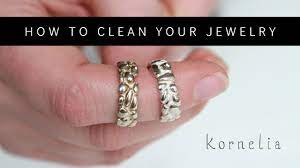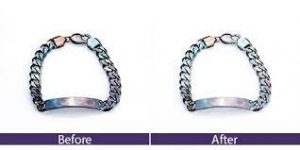
The 5 Best Ways To Remove Tarnish From Your Silver Jewelry
- Roger
- 0
- on Nov 25, 2022
The 5 Best Ways To Remove Tarnish From Your Silver Jewelry
There’s nothing quite like the feeling of putting on a piece of sparkling silver jewelry – whether it’s a delicate necklace, a statement ring, or a pair of earrings. But over time, even the most well-cared-for silver can start to tarnish and lose its luster. If your silver jewelry is looking dull and lifeless, don’t despair! There are several easy ways to remove tarnishes and restore your jewelry to its original shine.
One popular method for cleaning silver is using alum powder. Simply mix the powder with water to form a paste, then rub the paste onto the tarnished areas of your jewelry. Rinse with warm water and dry thoroughly. You can also clean silver with white vinegar. Just soak your jewelry in a mixture of one part vinegar to four parts water for about 15 minutes, then rinse and dry.
If you’re looking for a natural way to clean silver, try using lemon juice or baking soda. For the lemon juice, simply immerse your jewelry in the juice for 10 minutes, then rinse and dry. For baking soda, make a paste by mixing equal parts baking soda and water, then rub onto tarnished areas and rinse off.
If your silver jewelry is particularly dirty or tarnished, you may need to use a commercial silver cleaner. Be sure to read the instructions carefully before using any cleaner on your jewelry. Once you’ve cleaned your silver jewelry, be sure to store it properly to prevent future tarn
how to make jewelry to sell on Etsy
One of the best ways to make money on Etsy is to sell jewelry. But in order to do that, you need to know how to remove tarnish from your silver jewelry. Here are 5 of the best ways to do just that:
1. Use Baking Soda
Baking soda is a gentle abrasive that can be used to clean silver jewelry. Simply make a paste out of baking soda and water and use it to scrub your jewelry clean.
2. Use Vinegar
Vinegar is another household item that can be used to clean silver jewelry. Simply soak your silver jewelry in a mixture of vinegar and water for a few minutes before rinsing it off.
3. Use Lemon Juice
Lemon juice is another acidic substance that can be used to clean silver jewelry. Simply soak your silver jewelry in lemon juice for a few minutes before rinsing it off.
4. Use Aluminum Foil
Aluminum foil can be used to create a chemical reaction that will clean your silver jewelry. Simply place your silver jewelry in a bowl of aluminum foil and add a little bit of baking soda. The reaction between the two will cause the tarnish to lift off of your silver jewelry.

5. Use Toothpaste
Toothpaste is another household item that can be used to clean silver jewelry. Simply apply some toothpaste to a soft cloth and use it to scrub your silver jewelry clean.
What are the best ways to remove tarnish from silver jewelry?
There are a few ways that you can remove tarnish from your silver jewelry. You can use a polishing cloth, which is a soft cloth that is impregnated with a polishing compound. You can also use a jeweler’s rouge, which is a red paste that you apply to the jewelry with a soft cloth. Finally, you can use silver cleaner, which is a liquid solution that you apply to the jewelry with a soft brush.
How can you prevent tarnish in the first place?
Silver tarnishes when it’s exposed to sulfur or other chemicals in the air. You can keep your silver jewelry from tarnishing by storing it in a cool, dry place—like a jewelry box lined with felt—when you’re not wearing it. Jostling can also cause silver to tarnish, so avoid keeping your silver next to other pieces of jewelry in a drawer. You can also buy anti-tarnish strips that you can slip into your jewelry box, or invest in a small dehumidifier for extra protection.
What are some easy home remedies for removing tarnish?
There are a few easy home remedies for removing tarnish. One is to mix equal parts vinegar and water, and then soak the tarnished item in the solution for a few minutes. Another is to make a paste out of baking soda and water, and then rub the paste onto the tarnished area. Finally, you can try using lemon juice or cream of tartar. Just apply either one directly to the tarnish, let it sit for a few minutes, and then wipe it away.
What are some professional tips for removing tarnish?
There are a few professional tips for removing tarnish from your silver. First, you will want to use a mild dish soap and warm water to remove any surface dirt or grime. Next, use a soft cloth or sponge and lightly rub the silver in a circular motion. If there is still tarnish present, you can try using a commercial silver polish or make a paste out of baking soda and water. Apply the paste to the silver and let it sit for several minutes before wiping it off with a clean cloth.
How can you restore shine to dull silver jewelry?
There are a few ways that you can restore shine to dull silver jewelry. One way is to use a polishing cloth and gently rub the surface of the silver. Another way is to use a mild soap and water solution and lightly scrub the silver. Finally, you can use a professional silver polish or dip the silver in a silver bath solution.
how long does ion plated jewelry last
When it comes to ion plating, how long the finish will last depends on a few factors. The type of metal used, the thickness of the coating, and how often the piece is worn are all important considerations. With proper care, most ion-plated jewelry will last for many years.
The base metal underneath the ion plating is important to consider when determining longevity. For example, if you have a piece of sterling silver jewelry that is ion plated with gold, the gold coating will eventually wear away to reveal the sterling silver beneath. The reverse is also true – if you have a piece of gold jewelry that is ion plated with sterling silver, the silver coating will eventually wear away, revealing the gold beneath.
The thickness of the ion plating also plays a role in how long it will last. A thicker coating will generally last longer than a thinner one. However, a thicker coating may also be more prone to chipping or flaking over time.
Finally, how often the piece is worn also affects its longevity. Pieces that are worn frequently are more likely to show signs of wear sooner than those that are only worn occasionally. This is because the constant friction can cause the ion plating to chip or flake off. If you want your ion-plated jewelry to last for many years, it’s best to save it for special occasions and take care to avoid exposing it to excessive wear and tear.